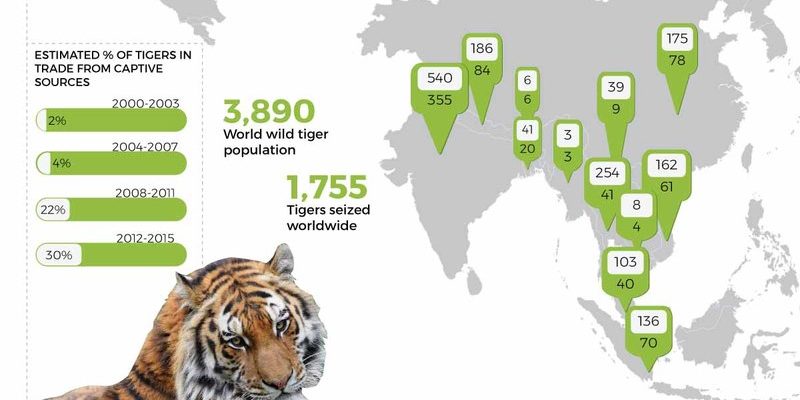
The Indochinese tiger, scientifically known as *Panthera tigris corbetti*, is primarily found in the regions of Southeast Asia, which can be quite lush and diverse. You might be wondering how these tigers manage their lives in such a vast area. Well, their distribution is fascinating, and understanding where they live helps us appreciate not just their beauty, but also the challenges they face in the wild.
The Range of Indochinese Tigers
Indochinese tigers inhabit several countries, including Thailand, Vietnam, Laos, Cambodia, and Myanmar. Each of these locations offers different types of environments, from rugged mountains to dense forests. It’s like having a favorite pizza joint in every neighborhood; each place has its own unique flavor that makes it special.
In Thailand, for instance, one of the most significant populations of Indochinese tigers can be found in Khao Yai National Park. This protected area is part of a larger ecosystem that provides the necessary cover and prey for tigers. You can picture the tigers moving stealthily through the underbrush, blending in with the foliage.
Meanwhile, in Vietnam, the situation is a bit more precarious. The population of Indochinese tigers has drastically declined due to habitat loss and poaching. It’s like watching a talented artist slowly fade from the stage—once vibrant, now struggling for attention.
Preferred Habitats of Indochinese Tigers
Indochinese tigers thrive in a variety of habitats but prefer tropical and subtropical forests. These dense jungles provide ample cover for hunting and allow them to stalk their prey effectively. Think of it as a nature-made game of hide and seek; the tiger is both the seeker and the hunted.
These tigers are also known to inhabit savannahs and grasslands, especially where water sources are available. They need access to rivers or ponds, not just for drinking but also for cooling off during those hot, tropical days. Imagine a big cat enjoying a refreshing splash in a creek. Isn’t that a lovely image?
Interestingly, the Indochinese tiger can sometimes adapt to different environments, including areas closer to human settlements. However, this is often a double-edged sword. While they can find food in these areas, the risks of encountering danger also increase.
Distribution Challenges: Habitat Loss
Unfortunately, the biggest threat to the habitat of Indochinese tigers is deforestation. As more and more trees are cut down for agriculture and development, these majestic creatures lose both their homes and their food sources. You could say it’s like trying to enjoy a meal in a restaurant where the menu keeps shrinking—eventually, there’s nothing left to eat.
In addition to deforestation, poaching is another major challenge. The illegal wildlife trade targets tigers for their beautiful fur and bones, which are often used in traditional medicine. It’s a cruel reality that highlights the need for stronger conservation efforts.
You might be wondering, “What can be done to help them?” Well, raising awareness is a huge part of the solution. Conservation groups work hard to protect their habitat and combat poaching. Supporting these organizations can make a real difference.
Neighboring Species and Ecosystem Balance
Indochinese tigers play a vital role in maintaining the balance of their ecosystems. They are apex predators, meaning they sit at the top of the food chain. By preying on animals like deer, they help control the population of these species, which in turn affects plant growth and the overall health of the forest.
In the same way that a key player in a sports team can change the dynamics of a game, the absence of tigers can lead to overpopulation of prey species. This can result in overgrazing, which impacts both plant life and the overall health of their habitat. It’s a delicate balance, and every piece counts.
Conservation Efforts and Protected Areas
Many countries with Indochinese tiger populations have created national parks and reserves to protect these big cats and their habitats. For example, Borneo’s Gunung Leuser National Park is a critical area that helps safeguard not only tigers but also a wide array of wildlife, including orangutans and elephants.
These protected areas offer a safe haven where tigers can roam and hunt without the constant threat of humans. But it’s not just about building fences. A robust conservation strategy must involve local communities to ensure long-term success.
Communities can benefit from ecotourism, where visitors come to see these magnificent creatures in their natural habitat. This creates a financial incentive for locals to protect the tigers rather than harm them.
Future of Indochinese Tigers
The future of Indochinese tigers hangs in the balance. Their populations are dwindling, and as habitat loss continues, the situation becomes more urgent. But there’s a silver lining. With ongoing conservation efforts, there’s still hope for these amazing animals.
It’s like a race—if we can rally together to protect their habitats, we can help ensure they continue to thrive. Whether through supporting wildlife organizations, spreading awareness, or even just encouraging responsible tourism, every little bit helps.
So next time you think about Indochinese tigers, remember that there are countless efforts happening to protect them and their homes. The journey is far from over, but with collective action, we can write a brighter chapter for these majestic creatures.
In conclusion, understanding where Indochinese tigers live is crucial not only for appreciating their beauty but also for realizing the responsibilities we have to protect their habitats. Each step we take towards conservation can help secure a future where tigers still roam the forests of Southeast Asia, enriching our world with their presence. Let’s take action together!

